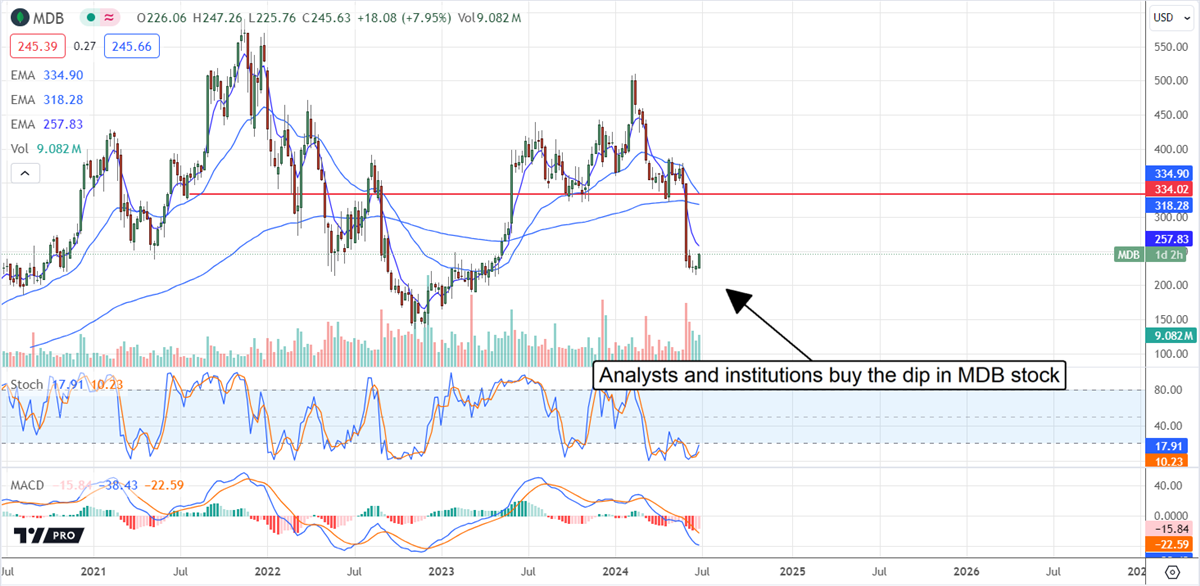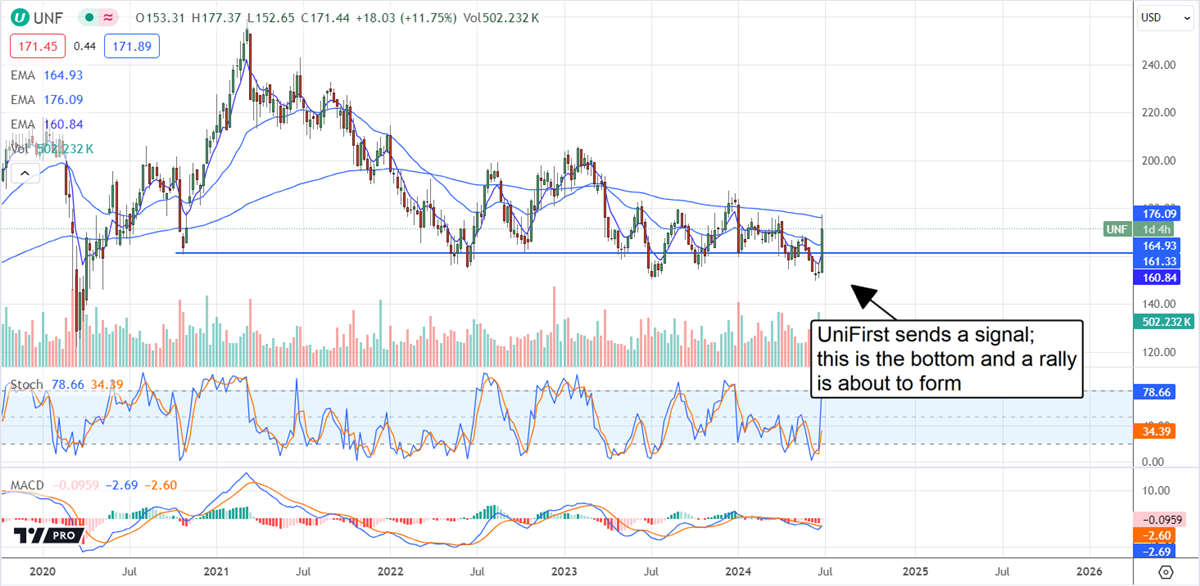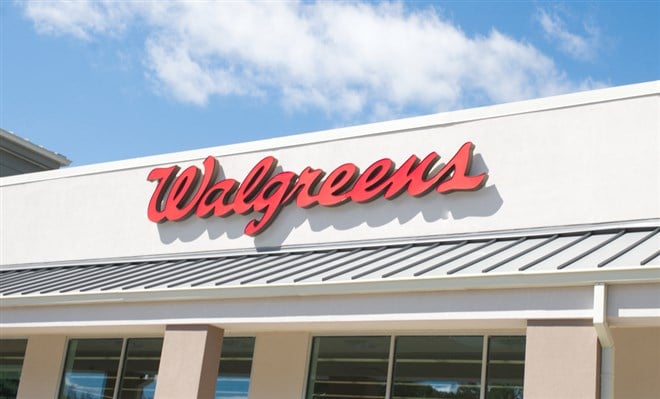Ticker Reports for June 29th
MongoDB Stock: Analysts Recommend Buying the Dip
Shares of MongoDB (NASDAQ: MDB) fell hard in Q2 for one reason and one reason alone- the guidance. Unlike other AI winners, the company’s guidance is for growth but tepid, anemic growth compared to the whisper expectations. The guidance resulted in a 50% decline for the stock from peak to bottom, assuming a bottom is in play, and 40% for the year, providing a deep discount for investors. The question is if it's time to buy the dip, and the answer may be yes.
The problem for MongoDB stock prices today is the timeline for AI development. The timeline includes a push to generate new AI-powered software and apps, which will come later. Today, the focus is on NVIDIA (NASDAQ: NVDA) and Advanced Micro Devices (NASDAQ: AMD) GPUs and accelerators needed for the infrastructure. The software and apps will come once the infrastructure is built and the models trained. Or so goes the theory.
Analysts' Conviction is High for MDB Stock
The analysts remain steady in their support for MongoDB despite the weaker-than-expected outlook. The news resulted in some price target reductions, but the takeaway is that this stock is a Moderate Buy with a 45% upside. The consensus is down from a peak set in the first half but still up compared to last year, and the stock is trading below the lowest target, suggesting real value is present.
Analysts' chatter following the Q1 release was favorable despite the declining targets. The takeaway is that weakened IT spending in the first half impacted the results, but the long-term outlook is much brighter. Like the proliferation of software companies that blossomed along with the Internet, AI is expected to drive a similar wave of software needs that MongoDB is positioned to facilitate. Its Atlas cloud database system, which uses and provides AI assistance, is easy to use; the free tier leads to paid clients and scales with business.
The latest update comes from Citigroup, which says it buys the dip. The firm is optimistic, putting MongoDB at the top of its list of enterprise software firms. While seasonal headwinds are hurting the outlook now, an inflection is coming for the stock that will include increased enterprise IT spending, lower interest rates, and seasonal estimate revisions. No price target was given.
Institutions are Buying the Dip in MongoDB: Short Covering May Start Soon
Analysts are not the only ones buying the dip in MongoDB. Institutional activity has slacked off from its peak in Q1 but remains bullish on balance in Q2. Institutional activity has been bullish on balance for three consecutive quarters and five of the last six quarters, bringing total ownership to nearly 90%. The May and June activity is exciting because it includes numerous triple-digit position increases, including a 400% increase for Plato Investment Management, a 300% increase for Cetera Investment Advisors, and a 200% increase for Western Pacific Wealth Management.
Short interest is also in play with this stock. The 6% short interest reported in mid-June isn’t enough to fuel a squeeze, but short-covering could aid upward momentum. As it is, the market is showing signs of a bottom that could lead to a rebound later this year. The bottom is near $245 and aligns with previous support seen in 2022 and a congestion band in 2023 that reveals intense market activity. Assuming the market sustains support at this level, a rebound could form soon.
Among the long-term drivers for the stock price is the business quality. The company is still generating GAAP losses but is profitable on an adjusted basis. It generates free cash flow, and free cash flow is growing. Highlights from the Q1 report include increased cash, no long-term debt, reduced liabilities, and a 20% increase in shareholder equity.

A lot of people are making this costly mistake
You may have heard the saying "options are risky" …
And, they can be. But only if you use them the way a lot of folks do.
A lot of people think of BUYING speculative options when they talk about options.
And BUYING low probability, speculative options is definitely risky…
It's how some folks leverage large sums of money hoping that a stock moves in the "right" direction over a certain period of time.
UniFirst Stock: Value-Building Sends a Signal to the Market
UniFirst (NYSE: UNF) is a quality business with savvy management working hard to improve shareholder value. The efforts include upgrading technology to the latest in enterprise resource planning (ERP) and customer relationship management (CRM) software, helping drive margin. While headwinds persist, they are diminishing and have the company set up to leverage its earnings growth as it scales. Today, the company’s operations sustain self-funded growth, a fortress balance sheet, dividends, and share repurchases. At face value, the company is reminiscent of the early days of larger competitor Cintas (NASDAQ: CTAS), which grew its share price by 800% in the last ten years and is now a Dividend King.
UniFirst Signals Wider Margin Improved Profitability
UniFirst’s Q3 results are much better than expected, with strength centered on the margin. The company reported $603.3 million in revenue for a gain of 4.6%, slightly ahead of the consensus estimate, with margins significantly wider. Revenue was driven by a 5.3% gain in the core laundry segment, offset by a slight decline in the Specialty segment. The mitigating details include seasonality in the specialty segment and the impact of CRM and ERP on the core business.
The company reported a 320 basis point improvement in core laundry operating margin and a 280 bps improvement in operating margin. That and the reduced impact of CAPEX spending relating to the ERP and CRM software resulted in double-digit increases in income and earnings. Operating income increased by 45% to $48.5 million, net income increased by 56.8%, and EBITDA by 29%. The net result is a 58% increase in diluted GAAP earnings, which outpaced the consensus reported by MarketBeat by $0.33.
News aiding the rise in share prices includes the guidance. The company maintained its outlook for revenue growth but increased earnings expectations. UniFirst execs increased the low end of the target range by 5.5% to above the prior range’s high end and may be cautious in their estimates. The focus on ERP and CRM should help it accelerate growth and widen its margin with a potential to match industry leader Cintas’s 21.6%, a gain of 1400 basis points over time.
UniFirst Capital Returns are Growing
UniFirst’s dividend yield isn’t market-beating, but it is among the safest payouts on the market. The 0.75% yield is offset by the payout ratio, balance sheet, and earnings growth, which support the outlook for distribution growth. The company has been making increases annually and can be expected to continue because the payout ratio is below 5%, and the balance sheet is a fortress. The pace of increases has slowed from the triple-digit pace it set earlier this decade but remains solid in the mid-single digits and will help compound returns.
UniFirst also repurchases shares to offset dilution and should continue for the foreseeable future. Regarding the balance sheet, the company has no long-term debt; total liabilities are a mere 0.2x of equity, with equity rising.
Analysts Drive UniFirst Stock Higher: The Bottom Is In
The trend in analysts' sentiment is only lukewarm but supports the market for the stock. Post-release revisions include increased price targets from JPMorgan Chase, Robert W. Baird, and UBS, which see this stock as ranging from $175 to $190 or 0% to 9% upside. JPMorgan sets the $175 target, the lowest target on record, providing a floor for the action that aligns with the price action.
Shares of UNF surged more than 12% on the news to trade near the $175 level. The move created a long green candle that shows support at a critical level while breaking to a three-month high. The market faces resistance at the $180 level but will likely overcome it as subsequent earnings reports are released later in the year.

How to build the ultimate dividend portfolio
There's a free dividend workshop that shows how anyone can build the ultimate dividend workshop in 3 basic steps?
PLUS: You'll get the names and tickers of the Best Dividend Stocks for FREE…
This way, by the time you finish the workshop you'll be fully equipped with the knowledge to start unlocking dividend checks for yourself… Over and over again.
Walgreens Stock Falls on Q3 Earnings Miss, Strategic Shifts Ahead
Walgreens Boots Alliance (NASDAQ: WBA) is a global leader in integrated healthcare, pharmacy, and retail. The company recently released its earnings report for the third quarter of 2024, raising questions about its ability to navigate a challenging market environment and achieve sustainable growth.
The company’s expansive network of approximately 12,500 locations across the United States, Europe, and Latin America makes it a critical player in providing healthcare services to millions daily. However, the latest financial performance reveals a company grappling with significant headwinds within the pharmacy industry and a rapidly evolving consumer landscape.
Third Quarter 2024: A Look at Walgreens' Numbers
Walgreens Boots Alliance's financial report revealed revenue of $36.4 billion for the third quarter, marking a 2.6% increase compared to the same period last year. While this top-line growth may appear positive, the company fell short of Walgreens’ analyst community’s earnings expectations. Walgreens reported earnings per share (EPS) of $0.40, significantly below the anticipated $0.68. The adjusted EPS, which excludes certain one-time items, came in at $0.63, reflecting a 36.6% decrease from the previous year's third quarter.
The company's operating income for the quarter was $111 million, while the adjusted operating income stood at $613 million. The disparity between reported and adjusted figures stems from factors like the inclusion of non-recurring expenses and the impact of accounting treatments for specific items. The missed earnings can be attributed to several interconnected factors, primarily a challenging environment for pharmacies and weaker-than-expected consumer spending in the United States.
Walgreens Adjusts EPS Forecast and Strategy
The challenging business environment and its impact on Walgreens's financial performance led Walgreens to revise its fiscal year 2024 guidance. The company now projects adjusted earnings per share to range between $2.80 and $2.95, down from the previously provided range of $3.20 to $3.35. This adjustment reflects a realistic assessment of the current market realities and their potential impact on the company's future earnings.
In response to these challenges, Walgreens's management has undertaken a comprehensive strategic review. The company aims to proactively address the critical issues affecting its performance and capitalize on emerging opportunities for growth in the evolving healthcare landscape. This strategic shift signals a proactive approach towards ensuring the company's long-term sustainability and success.
Streamlining Operations: Walgreens’ Plan for Improved Profitability
A key element of Walgreens Boots Alliance's strategic realignment is implementing a multi-year footprint optimization program. This program involves closing a significant number of underperforming stores in the United States. By streamlining its physical store network, the company aims to adapt to the changing dynamics of the retail landscape, optimize its operational efficiency, and improve overall profitability. This decisive action demonstrates the company's commitment to adapting to the evolving retail landscape.
In addition to footprint optimization, Walgreens Boots Alliance is implementing an action plan for U.S. Retail Pharmacy. This plan focuses on enhancing the customer and patient experience across all channels, including physical stores and digital platforms. Walgreens aims to strengthen its market position and drive sustainable growth in this crucial segment by investing in its core pharmacy business and prioritizing customer satisfaction.
Walgreens Boots Alliance is also simplifying its U.S. Healthcare portfolio as part of its strategic shift. This involves streamlining operations and focusing on key areas with the greatest long-term growth and profitability potential. The recent decision to close several VillageMD clinics and reduce investment in this segment underscores this strategic focus. This strategic realignment will allow Walgreens to allocate resources effectively and capitalize on opportunities in its core businesses.
Monitoring Walgreens' Strategic Transformation for Growth
The third-quarter earnings report from Walgreens Boots Alliance underscores the challenges facing the company and the pharmacy industry as a whole. While revenue growth remains evident, the company's struggle to meet earnings expectations and subsequent guidance adjustments signal a need for strategic adaptation. Investors should closely monitor the company's progress in executing its strategic turnaround plan, particularly the effectiveness of its footprint optimization program, the success of its U.S. Retail Pharmacy action plan, and the outcomes of its simplified U.S. Healthcare portfolio strategy.
The success of the footprint optimization program will hinge on the company's ability to identify and close truly underperforming stores while minimizing disruption to its existing customer base. A strategic approach to store closures and investments in digital channels and alternative store formats will be crucial to achieving the desired balance of cost reduction and revenue preservation.
Similarly, the success of the U.S. Retail Pharmacy action plan will depend on Walgreens’s ability to enhance the customer experience in tangible ways. This might involve leveraging technology to offer personalized services, improving in-store convenience, and providing a seamless omnichannel experience. Investors should look for evidence of increased customer engagement, higher customer satisfaction scores, and, ultimately, a positive impact on sales and market share within the U.S. Retail Pharmacy segment.
The third-quarter earnings report from Walgreens Boots Alliance highlights a company navigating a complex and changing market. While revenue growth is evident, the company's missed earnings expectations and adjusted guidance underscore the challenges ahead. Investors should closely monitor the progress of Walgreens’s strategic initiatives, including store closures, customer experience enhancements, and healthcare portfolio streamlining. The company's ability to adapt and execute its strategic plan will be critical for achieving sustainable growth and regaining investor confidence.






0 Response to "🌟 MongoDB Stock: Analysts Recommend Buying the Dip"
Post a Comment